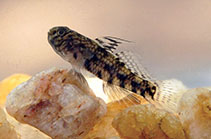| Family: |
Gobiidae (Gobies), subfamily: Gobionellinae |
| Max. size: |
4.9 cm TL (male/unsexed) |
| Environment: |
benthopelagic; freshwater; brackish; marine; depth range 0 - 5 m, amphidromous |
| Distribution: |
Asia and Oceania: Japan southward to the Philippines, Indonesia, New Guinea and Australia. Reported from Africa: south to Coffee Bay, South Africa (Ref. 2798) and Seychelles (Ref. 4343). Widely distributed over the West tropical Pacific, from Japan to the Philippines, Indonesia, New-Guinea, North of Australia, Vanuatu and New Caledonia (Ref. 87781). The Redigobius genus is actually being revised and especially the bikolanus group that should be splitted into several taxa, leading to a revision of the group distribution also (Ref. 87781). |
| Diagnosis: |
Dorsal spines (total): 7-7; Dorsal soft rays (total): 6-8; Anal spines: 1-1; Anal soft rays: 6-8. Distinguished by the following characteristics: 2-3 dark spot at caudal base (Ref. 2798); Redigobius with dusky scale margins forming network pattern; side of body variably marked with series of dark brown blotches or bars, one blackish, slightly oblique, narrow bar on side of body, second blackish narrow bar present on lower half of body; four distinct dark brown to blackish spots along mid-ventral line at anal fin; second dorsal rays I,6-8; anal rays I,6-8; pectoral rays 14-18; longitudinal scales 21-27; TRB 6 1/2 to 8 1/2; predorsal scales 5-8 (Ref. 84480). |
| Biology: |
Adults inhabit creeks, rivers and brackish estuaries (Ref. 2847, 44894). Found in tidal streams (Ref. 4343, 44894). Sometimes seen upstream a short distance from the tidal zone. Feed on small fishes and invertebrates. Not seen in markets (Ref. 12693). |
| IUCN Red List Status: |
Least Concern (LC); Date assessed: 26 August 2018 Ref. (130435)
|
| Threat to humans: |
harmless |
Source and more info: www.fishbase.org. For personal, classroom, and other internal use only. Not for publication.

